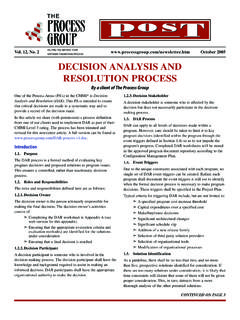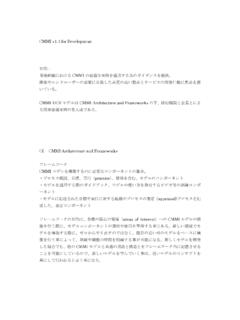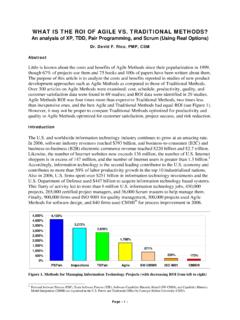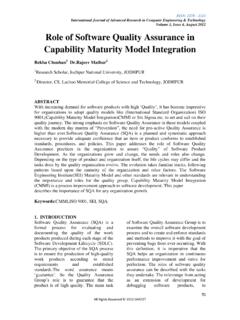Transcription of Best Practices for Enterprise Agile Transformation
1 Best Practices for Enterprise Agile Transformation A White Paper for the Software Development Project Community Date: May 2017 9841 Broken Land Parkway Suite 209 Columbia, MD 21046 2017, Select Computing, Inc. All rights reserved. Select Computing, Inc. Best Practices for Enterprise Agile Transformation 2017, Select Computing, Inc. All rights reserved. 1 | Page Best Practices for Enterprise Agile Transformation Select Computing, Inc. (SCI) can help your organization realize the benefits of Agile by guiding it through the transition from traditional software development life cycle (SDLC), such as the Waterfall, to Agile . SCi is experienced in Enterprise Transformation , establishing organizational best Practices for Agile methods, and managing cultural change throughout the project, program, and portfolio levels of an organization.
2 For Agile Transformation to succeed, an organization s processes, policies, and culture must all reflect Agile values. We partner with customers to develop a strategy and roadmap that facilitates the adoption of Agile within each organization s culture. Many customers desire to benefit from the positive impact the iterative and flexible approaches of Agile bear on projects and on project risk. The Agile approach is a significant departure from the traditional approach. The success of the Agile approach requires substantial changes in the way an organization plans and executes projects. The logical place to begin this Transformation is by changing the culture of the organization. SCi recommends using the IDEAL (Initiating, Diagnosing, Establishing, Acting, Learning) framework to manage the cultural change.
3 IDEAL is a process improvement methodology advocated by the Software Engineering Institute (SEI). The Agile best Practices such as Scrum or Extreme Programming assume a small, self-managing, co-located team. When an organization runs a single project, these approaches work well. However, challenges increase when coordinating multiple teams working on a large-scale, complex project with numerous iterations to deliver releases that provide stakeholder value. To address scaling Scrum and Agile at the Enterprise level, a number of scaling approaches have gained attention including the Scaled Agile Framework (SAFe) ( ). Agile Transformations require organizational commitment and a high level of process maturity. SCi has undertaken the same change internally and within projects we execute for our customers.
4 We are highly qualified to guide organizations through this cultural Transformation . SCi incorporates Agile principles within our vision and mission. All corporate and commercial functions employ the same Agile approach for managing the work. The key lesson learned from our decade-long adoption of Agile principles is that Agile requires a sound structure to operate within, and a robust management foundation. The management foundation we employ, and recommend for our customers, is the Capability Maturity Model Integrated (CMMI). Our Agile approach has been independently appraised at CMMI maturity level 4. CMMI can be used to guide process improvement across a project, a division, or an entire organization. Our Concept Our approach for Enterprise Agile Transformation blends well established management Practices depicted in Figure 1, and defined below.
5 Rated at CMMI Level 4, for both Development and Services Best Practices for Enterprise Agile Transformation 2017, Select Computing, Inc. All rights reserved. 2 | Page constellations, SCi specializes in blending and leveraging the flexibility of the Agile approach with the predictability of mature continuous improvement best Practices of CMMI and program management best Practices of the Project Management Institute s Body of Knowledge (PMBoK). Figure 1. Best Practices Best Practices Definitions: Agile software development refers to a group of software development methodologies based on iterative development, where requirements and solutions evolve through collaboration between self-organizing cross-functional teams. Six Sigma is a set of techniques and tools for process improvement.
6 It improves business processes by defining, measuring, and analyzing workflows in order to reduce defects in an organization's products and services. Capability Maturity Model Integration (CMMI) is a process improvement approach that provides organizations with the essential elements of effective processes. It is a capability model developed by the Software Engineering Institute (SEI) along with a group of government and industry representatives. Continuous Improvement is an ongoing effort to improve products, services, or processes through incremental and breakthrough improvements. Scrum is an Agile framework for completing complex projects. A Scrum process is distinguished from other Agile processes by specific concepts and Practices , divided into the three categories of Roles, Artifacts, and Time Boxes.
7 The Project Management Body of Knowledge (PMBoK) is the preeminent global standard for project management. It provides project professionals with the fundamental Practices needed to achieve organizational results and excellence in the practice of project management. Best Practices for Enterprise Agile Transformation 2017, Select Computing, Inc. All rights reserved. 3 | Page Establishing an Agile culture requires SCi to establish a uniform and standard set of processes that define Agile Governance of projects and work efforts and Agile Operations of the Enterprise IT environment. In order to deploy an Enterprise -wide Agile training program, we must first ensure that Agile Governance and Operations processes are well defined. Based on this foundation, we can proceed with training and deployment necessary to effect the Transformation .
8 Our approach is straightforward. SCi conducts analysis of existing processes and specification of the new Governance and Operational processes. We define and refine each organization s process by structuring it using the Deming Cycle: PDSA (plan-do-study-act) or PDCA (plan-do-check-act). We implement corporate governance by institutionalizing the DMAIC (Define, Measure, Analyze, Improve, Control) process to improve, stabilize, and optimize the processes. The IDEAL Model Institutionalization of the new processes and governance requires cultural change. SCi uses the IDEAL framework developed by the Software Engineering Institute (SEI) to manage culture change in organizations. The IDEAL Model consists of five phases: Initiating, Diagnosing, Establishing, Acting, and Learning. These phases are closely connected with each other to form a continuous cycle of process improvement.
9 Figure 2 depicts the SCi Integrated Approach for Agile Transformation . Figure 2. SCi Integrated Approach for Agile Transformation For example, for a Government Agency, SCi applied the integrated culture change model depicted in Figure 2. When this was completed, our customer was left with the necessary business process Best Practices for Enterprise Agile Transformation 2017, Select Computing, Inc. All rights reserved. 4 | Page framework that supports Agile in a large organization. The customer was able to continue applying the culture change model to expand and complete the Transformation throughout the agency. The Deming Cycle ( ) is an established best practice for gathering the necessary information to enable continuous process improvement. As a result, the definition of each business process uses the Deming Cycle as its blueprint as a reflection of the organization focus on process improvement.
10 The DMAIC ( ) is a data-driven strategy for process improvement. It is an integral component of Six Sigma. It provides for a quantitative approach to managing and operating processes. IDEAL ( ) has been the gold standard for process improvement since 1996 and since then continues to be used in numerous industries as the Best Management Practices to support process improvement and culture change. IDEAL provides a usable, understandable approach to continuous improvement by outlining the steps necessary to establish a successful improvement program. Following the phases, activities, and principles of the IDEAL model has proven beneficial in many improvement efforts. The model provides a disciplined engineering approach for improvement, focuses on managing the improvement program, and establishes the foundation for a long-term improvement Process Agile governance is crucial to successful realization of the benefits of Agile .






